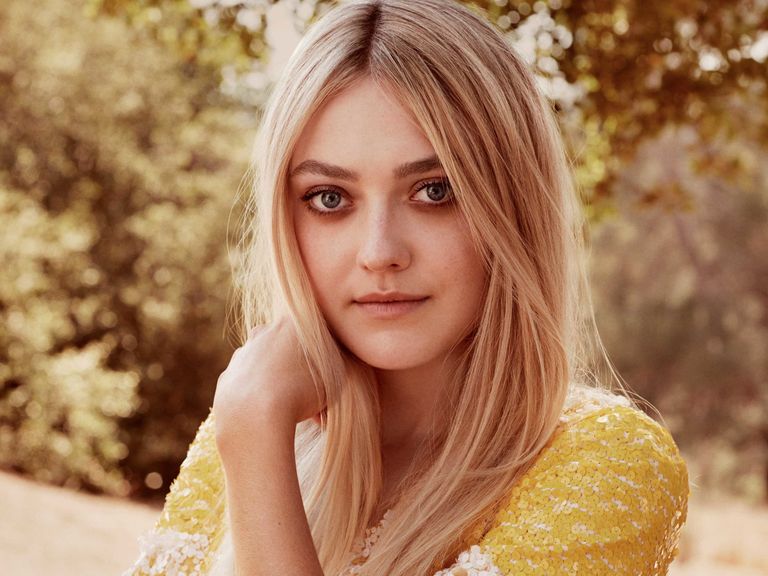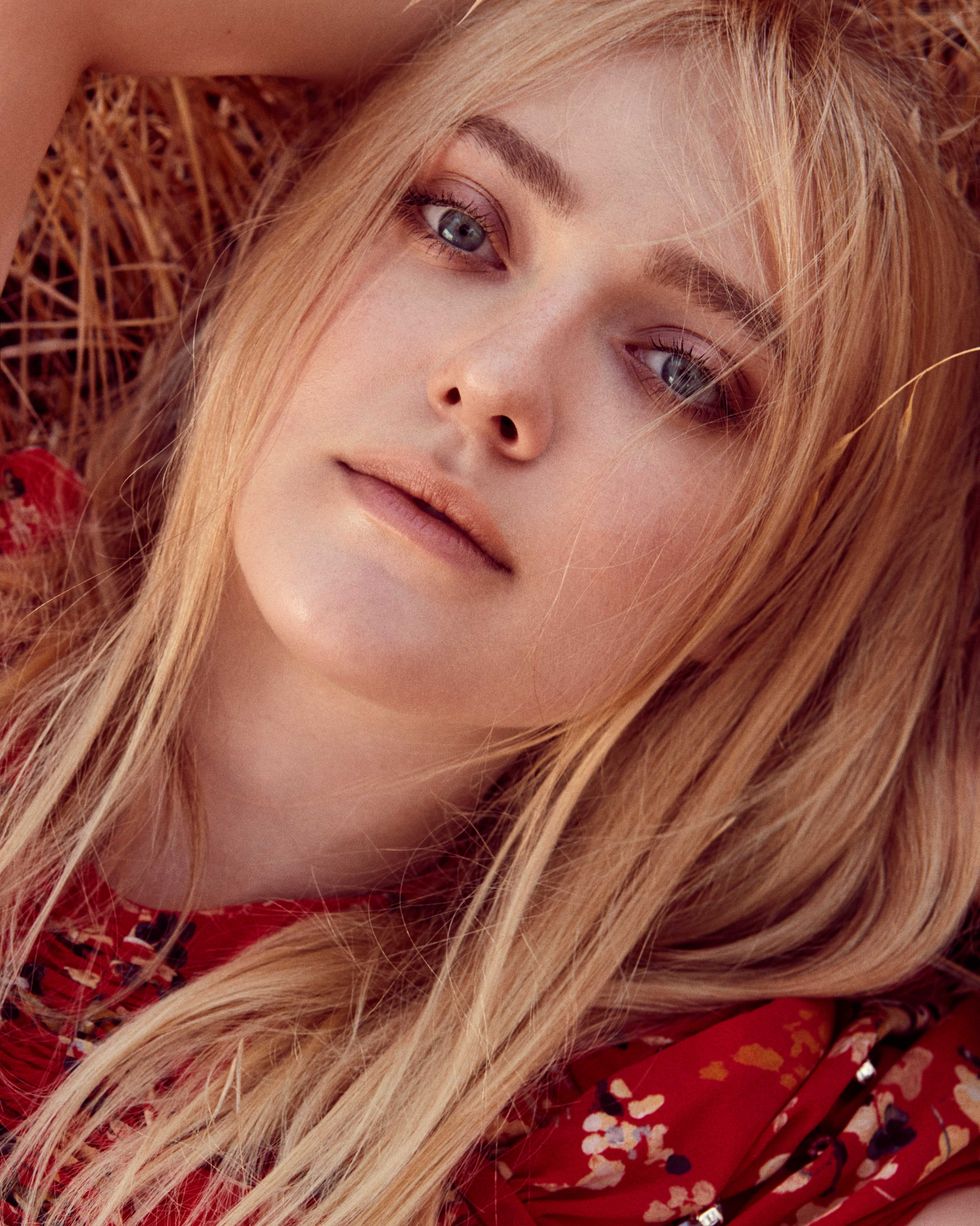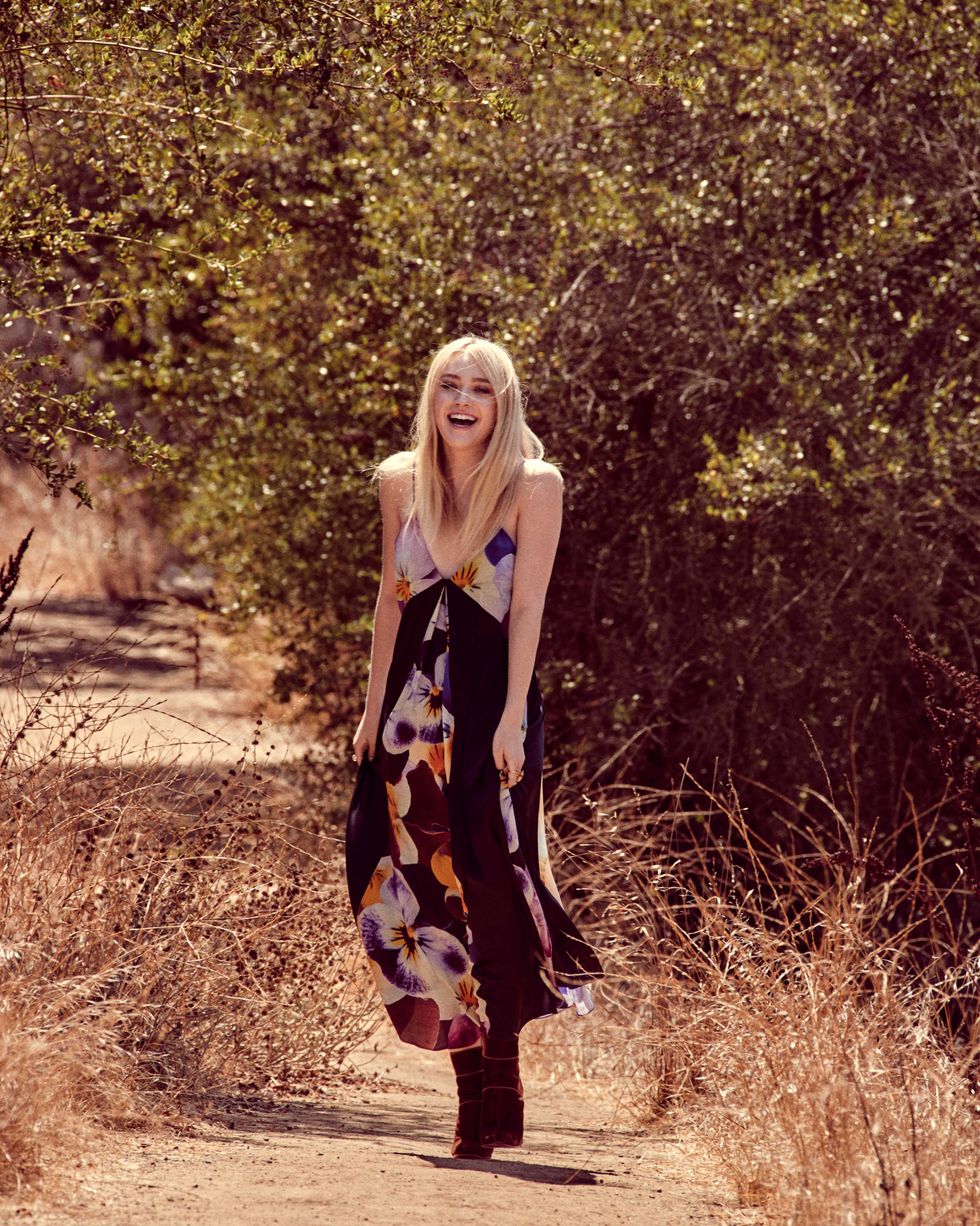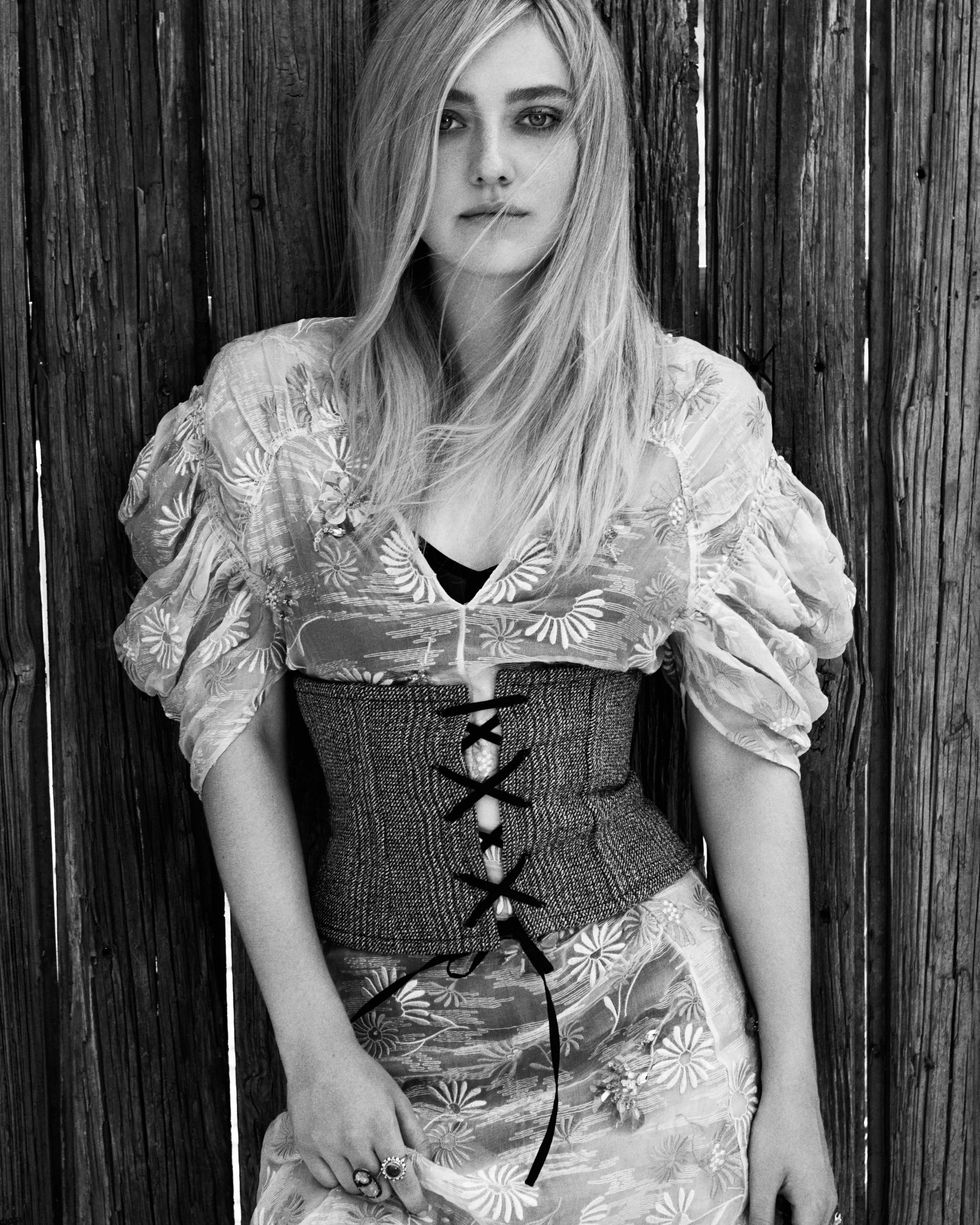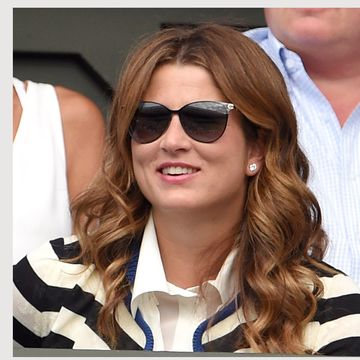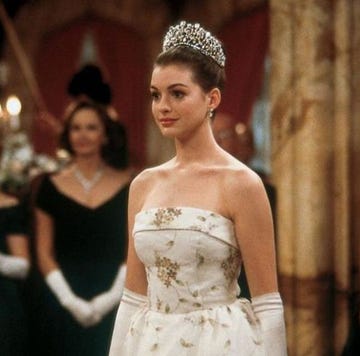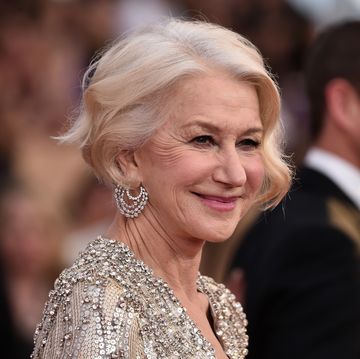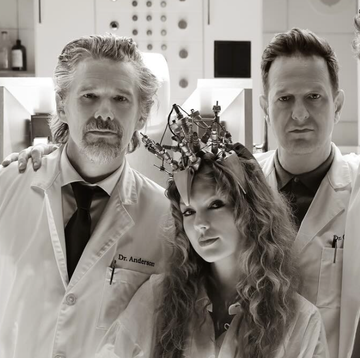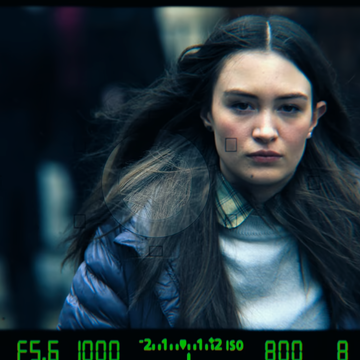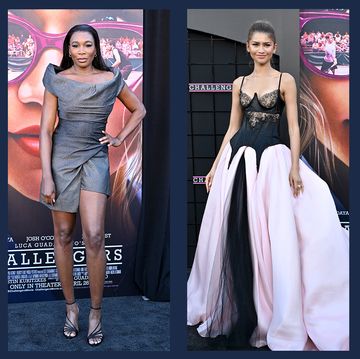It's an odd place to begin, but perhaps the only place: with Dakota Fanning talking about Charlie Sheen. We're seated on the terrace of the Sunset Tower in West Hollywood, and Fanning, dressed in a black slip dress and embroidered Alberta Ferretti mules, is talking about one of her first jobs: an episode of Spin City when she was six. "Charlie Sheen gave me a signed headshot," she says. "I think it said, 'Keep it real.' But real was spelled reel, like a film reel." She laughs at the specificity of the memory, and maybe also at this crazy town, where a six year-old might covet an autograph from Charlie Sheen. "I loved Charlie," she says. "He gave all of the kids a headshot. That was a really nice thing to do."
By the time some child stars turn 22, they're angling for an appearance on Dancing with the Stars or adjusting the lighting for their sex tape. Former kid actors can be like walking click bait (You'll never guess what she looks like now!), but Fanning is something different, having matured into a keen observer of human behavior and doing some of her most challenging work. If the transition has been seamless, that may be because she was always actually a tiny adult.
At age eight she won a Critics Choice Award for her performance in I Am Sam. Orlando Bloom memorably had to pick her up to reach the microphone. Then she spoke for three full minutes. Fanning appeared in more than a dozen films before her 14th birthday, but she was never just along for the ride. Long before equal pay became a hot topic in Hollywood, she was fighting to have her name where it belonged, firmly above the title, and commanding $4 million a movie. She was a fashion muse, too—and a controversial one at that, appearing in a banned 2007 Marc Jacobs campaign cradling a phallic bottle of his perfume Oh, Lola! between her legs.
But there was more to the story, she says, than what the public assumed. She was not the precocious child parodied on Saturday Night Live, where Amy Poehler played her as the self important host of "The Dakota Fanning Talk Show." Proof of Fanning's real, three-dimensional growing pains are on display this fall in American Pastoral, the big-screen adaptation of Philip Roth's novel about the troubled teenage daughter of a beauty queen and a sports hero who sets off a bomb in protest of the Vietnam War.
Watching the film, one is reminded of the perils of homegrown terrorism but also about how few roles there are for women in which the character's main goal isn't to get married or have a baby. With American Pastoral, Fanning appears to be drawing a clear line in the sand; although she never stopped working, this feels like a major reintroduction, an awards contender that shows off her maturity and range. The audience meets her first as a stuttering teenager (in chic knits and period-perfect patent leather loafers), then again as a coed radical; a year after that she's living in poverty, her teeth rotting as she punishes herself. The final confrontation with her father is the film's best scene, and perhaps her reason for taking on the role at this inflection point in her career.
Of the film Fanning says, "I think it's really about expectation versus reality—of what you think your life is going to be and what you think other people's lives are going to be. I think it's really about breaking the idea of what people think is true."
Sitting with Fanning, who is wearing a hulking 1950s men's Rolex on her wrist, I'm reminded of a passage from American Pastoral, a novel that argues that people are essentially unknowable. The narrator, Nathan Zuckerman, says, "You get them wrong before you meet them; you get them wrong while you're with them; and then you go home to tell somebody else about the meeting and you get them all wrong again.'' The same could be said of Fanning's own teenage years.
I tell her we have this idea of her "as the perfect child," she says, finishing the thought, rolling her huge blue eyes. "Which is fine. It is. I'm a very private person. I've been thinking lately about how much do I care what other people's preconceived notions of me are. They definitely exist. They always will, to an extent, because I've been acting for 16 years already and I'm 22." That SNL sketch offers a perfect distillation of those perceptions, with Poehler explaining her appearance in The Cat in the Hat by saying, "In my defense, I saw it as a metaphor for ethnic violence in central Africa. But apparently it was about a cat in a hat! Speaking of books, have you read the new Pynchon?"
Of the sketch Fanning says, "I'm sure it's hilarious. I just haven't seen it." But in a way that's the caricature she's out to rewrite. As she grew up, we never saw Fanning stumble out of a cab. She never got a fake ID. "I was raised by very traditional Southern parents with Southern manners," she says. "You don't air your dirty laundry to people that aren't your family or your friends. Why would I ever want to portray myself as anything other than together?"
Considering she's been an Oscar voter since she was 12 (she was the youngest person ever invited to join the academy), her childhood was refreshingly real. Whether it was a conscious choice or not, she seemed determined to prove that she wasn't just a child actor—that she was also a child. After some early success in commercials, including a spot for the Georgia State Lottery opposite Ray Charles, her mother asked if she'd like to move to Los Angeles, and she responded with a pint-size "Hell, yes." After the success of I Am Sam, Fanning never stopped working. Though she was largely home-schooled and tutored on sets, she decided to have a traditional high school experience, enrolling at Los Angeles's prestigious Campbell Hall, where she joined the cheerleading squad and was twice voted homecoming queen.
Fanning enrolled at New York University in 2011, forgoing a dorm room for a $10,000-a-month two-bedroom Soho apartment in a building whose tenants included John Mayer and Tyra Banks. But she was otherwise a regular college student. Although paparazzi photos of her surface now and then, the public has mostly given her space—to eat pizza late at night with her sister Elle or to sing karaoke in the East Village. (Carrie Underwood's "Before He Cheats" is her go-to. "By the end of the night I let myself go and I'm just screaming. It's not about being good. I don't care about that.")
She loves the spontaneity of the city, and the anonymity. "Everyone in New York is very self-involved," she says, and it sounds like a compliment. "They're focused on themselves. Like, walking down the street, people are just in their own zone. There are times where you do snap. Someone bumps into you one too many times, and you're just like…" Which is to say Fanning isn't some porcelain doll perched atop a shelf for safekeeping. She's living her life.
Actors aim to disappear into roles, and Fanning is no different. Whether she's a centuries-old vampire in the Twilight saga or rocker Cherie Currie in The Runaways, she's never less than committed. But audiences can't help coming with expectations. In a way, our shared history with Fanning only adds to American Pastoral's impact. She is in just a few scenes before her character, Merry, blows up a post office and goes into hiding. Her father, played by Ewan McGregor (who stepped up to direct the film after Phillip Noyce left the project), spends much of his screen time searching for her, trying to understand how he raised a terrorist. We too find ourselves feeling Fanning's absence.
There's a scene early on in which McGregor's character, Swede Levov, is returning from an awards ceremony when Merry rips into him. What's so searing about Fanning's performance is the fire in her eyes. This woman isn't crazy—or maybe she is—but her actions are rooted in a very real fear. She grew up privileged but has found herself powerless, and she's acting out to the extreme. Few people would have chosen the slow clap to dramatize her resentment, as it's such an '80s movie cliché, but when Fanning does it to McGregor, deftly emasculating him, it's killer. McGregor recalls being on the receiving end of that ire: "It was so devastating to stand there. It felt very demeaning to be clapped at like that."
It may be interesting to take stock of your life at 22, but when you've been working for 16 years it also may be natural. Fanning has been thinking a lot about the state of women in Hollywood these days—not only is she getting older, it's her major. She's entering her senior year at NYU, and she has developed her own curriculum, studying the portrayal of women in film. A recent examination of Taming of the Shrew really got under her skin, she says. "The issues that are being made fun of in that play—gender roles and gender disparity and marriage and male ownership of a woman—all of that was written in the 1500s. We are still having the same conversations now, which is insane."
When asked if she has ever been hit on or subjected to lewd comments at work, she says, "I've been lucky that I haven't had anything directly done to me. It's different when you're a kid. People protect you from that." As she has gotten older, she says, she has noticed "an energy change. I'm sure it will happen soon. Hopefully not, but odds are it probably will."
Hoping to wrest control of that conversation, Fanning is starting to produce movies—notably an adaptation of Sylvia Plath's The Bell Jar that she hopes to shoot in the spring. She chose Kirsten Dunst to direct the film, which Fanning will star in, and though Dunst had directed only short films before, there was a kinship between the actresses. "I think that Kirsten and I have had a very similar experience, in that we started so young," Fanning says. "We've lived a couple of lifetimes. I just trust her."
The Bell Jar isn't a biopic; it's more a roman à clef about a young woman interning at a magazine in New York City. It deals with depression, serving it up with irony and humor. For Dunst, Fanning's ability to portray the internal life of a character is what made the project so thrilling. "Her soul is onscreen," Dunst says. "She's a beautiful face to watch; she's very translucent and doesn't hide anything. She can portray anything."
Fanning does seem perfectly suited for the part. She's not just the right age, she's at the right point on the emotional curve of her life. The actress, who has graduation in sight, recently split up with British model Jamie Strachan, her boyfriend of two years, and while she declines to elaborate on the breakup, she appears to be encouraged by the single life—even if she has a serious disdain for first dates. "The way I prefer to meet someone is through a friend," she says, because that means the person "is most likely not a freak." Even then, she says, "I find dates, in general, horrific. We have to sit there and ask these questions and pretend to eat a meal, and it just feels so stiff."
Fanning prefers to move into new situations—personal or professional—with a bit more grace and fluidity. Maybe that's why her saying goodbye to childhood isn't her issue but our own. Even her parents sometimes stumble with it. Fanning is in L.A. this week (before heading to the Venice Film Festival to promote her upcoming role in Brimston), and she's been sleeping in her childhood bedroom, which was recently renovated—an experience that was far more traumatic for her mother than for her.
"I had wallpaper in my room my whole life," Fanning says. "And my mom called me, because there was a leak in the wall. She was very distressed, like, 'So, we are going to probably have to take the wallpaper down from your room. Are you okay with that?' I liked the wallpaper just fine, but, you know, I didn't have an emotional collapse because the wallpaper is going to be removed. I was like, 'Mom, just paint it.'"
Styled by Nicoletta Santoro
Photographs by Victor Demarchelier
This article originally appeared in the November 2016 issue of Town & Country.

